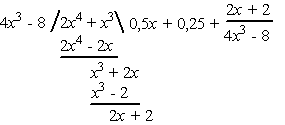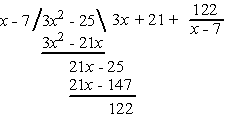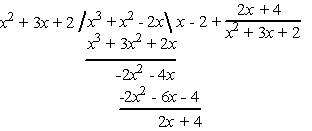|
|||||
| 1. | a. |
 |
|||
| De asymptoot is de lijn y = 1/2x + 1/4 | |||||
| b. |
 |
||||
| De asymptoot is de lijn y = 3x + 21 | |||||
| c. |
 |
||||
| De scheve asymptoot is de lijn y = x - 2 | |||||
| 2. | a. |
√(x2 + 2x) =
√(x2 + 2x + 1 - 1) = √((x + 1)2
- 1) ≈
√((x + 1)2) =
±(x + 1) Voor x heel groot positief staat er y = x + 1 Voor x heel groot negatief staat er y = -x - 1 of: (voor x positief) |
|||
|
|
|||||
| De asymptoot zal daarom de lijn y = x + b zijn. √(x2 + 2x) - x = √((x + 1)2 - 1) - x ≈ (x + 1) - x = 1 dus b = 1 De asymptoot is y = x + 1 |
|||||
| b. |
|
||||
| Als x heel groot (positief
of negatief) wordt, wordt 1/x gelijk aan
nul. Dan staat er ongeveer e0 • (1 - 0) = 1 De scheve asymptoot zal de lijn y = x + b zijn. |
|||||
| Bekijk daarom f(x)
- x: xe1/x - x = x(e1/x-
1) Het is onduidelijk wat daar uitkomt. x wordt oneindig groot, maar dat stuk tussen haakjes wordt 0.... Y1 = xe1/x - x in de GR invoeren maakt snel duidelijk dat voor erg grote x dit naar 1 gaat. Dus de scheve asymptoot is de lijn y = x + 1 |
|||||
| c. | f '(x) = 1
- e-x Voor x heel groot gaat dit naar 1, dus de asymptoot is de lijn y = x + b f(x) - x = x - e-x - x = -e-x en dat gaat naar nul De scheve asymptoot is de lijn y = x |
||||
| 3. | a. |
|
|||
| f '(0) = ((-2 • -3) - 0)/9 = 2/3 | |||||
| b. | De
verticale asymptoot is x = 3 Maak een staartdeling: |
||||
 |
|||||
| Die
laatste breuk gaat naar nul, dus de scheve asymptoot is de lijn y
= x + 1 Dan is S het punt (3, 4) Twee naar rechts en b omhoog geeft de functie: |
|||||
 |
|||||
| (3, 4)
invullen geeft 4 = (1 - 2 • 1)/(-2) + b 4 = 1/2 + b b = 31/2 |
|||||
|
© h.hofstede (h.hofstede@hogeland.nl) |
|||||